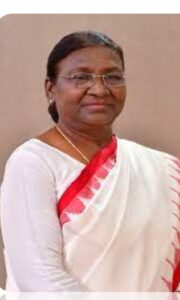Table of Contents
Introduction
Smt. Droupadi Murmu is the current and 15th Indian president. Before Becoming the president she was the Governor of Jharkhand from 2015 to 2021. The President of India is the head of the state and supreme commander of all 3 forces of the Indian Republic.
The President is chosen through an indirect electoral process involving members of both houses of Parliament and representatives from the legislative assemblies of states and union territories. The President has significant powers, including appointing the Prime Minister, governors, and judges, and representing India internationally.

Role and Responsibilities of the Indian President
Here are some roles and powers
1. Head of State and Supreme Commander: The President is the highest authority in the country and leads the Indian Armed Forces.
2. Safeguarding the Constitution: The President’s top priority is to protect and uphold the Indian Constitution and laws.
3. Qualifications: To become President, one must be an Indian citizen, at least 35 years old, and not hold any other government position.
4. Residence: The President lives in Rashtrapati Bhavan, located in New Delhi.
5. Vacancy in Office: If the President can no longer serve due to various reasons like death, resignation, or removal, the position becomes vacant.
6. Authority in Various Areas: The President has power in many areas including official matters, legal issues, foreign relations, and military matters.
7. Decision Making: The President makes important decisions based on advice from the Prime Minister and a group called the Council of Ministers.
8. Checking the Lower House: The President has special powers to keep the Lok Sabha, which is the lower house of Parliament, in line.
9. Salary and Benefits: The President receives a monthly salary of Rs. 5 lakh along with other allowances and benefits.
Powers
Executive Power of President
- He has the power to establish rules for authenticating official documents and instruments, as well as to streamline the administration of government business and allocate tasks among ministers. (Article 77)
- He has the authority to appoint the Prime Minister and other ministers, as well as other key officials such as the Attorney General, the Comptroller and Auditor General, and State Governors etc. (Article 75)
- He can also request information from the Prime Minister and other ministers. He can initiate investigations into the conditions of marginalized communities and promote cooperation between the central government and the states. (Article 78)
- Additionally, he has the authority to appoint administrators for Union Territories (Article 239) and has the power to declare certain areas as scheduled or tribal areas (Article 244).
Judicial Powers of the President
- He also can consult the Supreme Court for advice on legal or factual matters, though the advice given is not binding on him. (Article 143)
- Additionally, the President has the authority to grant clemency, including pardons, reprieves, and commutations, to individuals convicted of offenses and can suspend or reduce sentences. (Article 72)
Legislative Power of the President
- He addresses the Parliament at the commencement of the first session after each general election and the first session of each year. (Article 87)
- He sends messages to the Houses of Parliament, whether concerning a bill pending in the Parliament or otherwise. (Article 86)
- He nominates 12 members of the Rajya Sabha from amongst persons having special knowledge or practical experience in literature, science, art, and social service. (Article 80)
- He decides on questions as to the disqualifications of members of the Parliament in consultation with the Election Commission. (Article 103)
- His prior recommendation or permission is needed to introduce certain bills like the money bills in the Parliament. (Article 117)
- He can promulgate ordinances when Parliament is not in session. (Article 123)
Financial Powers of the President
- Money bills can be introduced in Parliament only with his prior recommendation.
- He causes to be laid before the Parliament the annual financial statement (i.e., the Union Budget). (Article 110)
- No demand for a grant can be made except on his recommendation. (Article 113)
- He can make advances out of the contingency fund of India to meet any unforeseen expenditure. (Article 267)
- He constitutes a Finance Commission every five years to recommend the distribution of revenues between the Centre and the states. (Article 280)
Diplomatic Powers and Functions
- The international treaties and agreements are negotiated and concluded on behalf of the President. However, they are subject to the approval of the Parliament. (Article 253)
- He represents India in international forums and affairs and sends and receives diplomats like ambassadors, high commissioners, etc.
Emergency Powers and Functions
National Emergency (Article 352)
President’s Rule (Article 356 & 365)
Financial Emergency (Article 360)
Salary of the President
As per the Second Schedule of the Indian constitution, the Indian president was paid 1.5 Lakh rupees as salary. With this various perks, allowances, and compensation are also given to the president. In 1998 the salary was raised to 50,000 per month which was equal to 1,90,000 rupees in 2020.
1. Residence: The official house of the Indian President is Rashtrapati Bhavan which is situated in capital New Delhi. This legendary residence is stationed on elevated ground or small hills. It has around 340 rooms and covers a broad floor whose area is around 2,00,000 square feet.
2. Medical Benefits: The president is the most important citizen of the country that’s why provided with free medical aid with lifetime access.
3. Security: Presidents have a vital role to play in politics and security of the nation and need to be protected that’s why a custom-built heavily armored Mercedes Benz S600 (W221) Pullman Guard is given to the accommodation of the president. For official visits the president uses this heavily armed and highly protected vehicle with a stretch limousine to increase security. The Caravan also involves a former presidential car, a black Mercedes Benz W140.
